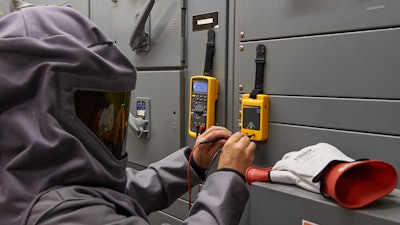
Electrical workers unanimously agree that there is an opportunity to build a culture of safety in the workplace according to a 2020 Fluke survey. Since that survey and the coming of the pandemic, the connection between workplace safety and health now go hand in hand. According to Chuck Pettinger, Ph.D., a safety expert at Predictive Solutions, while it can take years to change a company’s culture, there are a number of positive steps an organization can take to build a climate of safety today, including taking steps to keep coworkers and family safe from coronavirus.
“Culture is not something that actually can be measured. Everyone talks about safety culture, organizational culture. What people actually are talking about is organizational climate; the stuff that we can impact on the day-to-day basis is the climate in which we work,” says Pettinger.
To begin growing your climate of health and safety, he suggests looking at changing three areas:
- Set goals that communicate safety as a priority
- Get workers engaged in safety
- Train outside of the classroom
1. Set goals that communicate safety as a priority
The first steps to build a successful program start with how you talk about safety. The types of goals you set can communicate how much of a priority safety is within the company. Use specific goals, metrics, and incentives to track your company’s progress toward a strong climate of safety. Pettinger recommends focusing on positive metrics, and short-term, attainable goals, such as S.M.A.R.T. goals:
- Specific
- Motivational
- Achievable
- Recordable
- Trackable
However, Pettinger does warn against using injury metrics or counting how many days since the last injury or accident. Instead of helping employees think safely, this kind of tracking tends to cause employees to not report incidents, so they don’t break the streak.
Instead, focus on tracking the positives like how many employees participate in a safety meeting or the quality of safety inspections. Include tracking a metric around health during this pandemic, like employees regularly washing their hands. Pettinger says, “People already operate in a safe manner, we can adjust the workplace to make it easier to do safe COVID behaviors, like social distancing and washing hands, and more difficult to do risky COVID behaviors.” Pettinger has also found that people are more motivated to improve something rather than avoid or reduce something like injury rates.
2. Train outside of the classroom
Whether you’re creating an entirely new training program or building onto an existing program, it can take time to make sure the learning becomes part of the employee’s day-to-day actions and thoughts. In Pettinger’s experience, one of the hallmarks of a good safety training program is to make it personal. How safety is trained should go hand in hand with how you talk about safety.
Dr. Pettinger suggests communicating when a worker is at risk of injury and using that moment as a teaching opportunity. Walk through the safest steps to complete the task instead of policing or reprimanding employees. This can erode any progress made toward a climate of safety by focusing on the negative. This helps to create the kind of climate where employees feel comfortable asking questions and continually learning. It also creates a conversation around making safe choices instead of a shame and blame game if risky behavior is seen. These kids of conversations take safety training out of a formal classroom setting and creates a more personal, everyday learning experience.
3. Get workers engaged in safety
Beyond what you track and how you talk about safety, the individual workers, especially leaders, need to be involved in safety. Along with the short-term goals mentioned in section 1, creating incentives can further keep workers engaged in the process. These can have a large influence on behavior, but they need to be the right types to send the correct message. Incentives that get workers excited about their job while still having a safety lens are what you want to look for. A great example Pettinger suggests is planning spontaneous recognition around a positive milestone like a virtual happy hour when the team hits one thousand safety observations.
Hosting regular safety, or pre-shift meetings is another opportunity for employees to get involved. It’s a great time to include reminders and talk about the basics, like personal protective equipment (PPE) and hand washing. Pettinger has seen some successful programs around these kinds of meetings and suggested expanding the conversations to include all factors of safety during this pandemic.
Adding an incentive like earning points for participating or presenting during safety meetings can help get employees to speak up. These points could then be saved up for a gift card or donations to a local charity. This is both an incentive for employees and a short-term goal to work toward while getting employees more engaged in safety.























